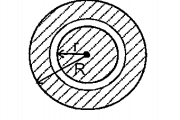Suppose a narrow smooth circular tunnel of radius r is dug inside earth(radius=R) If a particle moves along that tunnel with constant speed without touching its surface then time period of rotation is

2π√Rg
2π√rg
2πR√gr
2πr√gr
The correct Answer is:A
Topper's Solved these Questions
Similar Questions
If a smooth tunnel is dug across a diameter of earth and a particle is released from the surface of earth, the particle oscillate simple harmonically along it
Time period of the particle is not equal to
View SolutionA particle moves along a circle of radius R with a constant angular speed ω . Its displacement (only magnitude) in time t will be
View Solution
Knowledge Check
Under the influence of a uniform magnetic field a charged particle moves with constant speed V in a circle of radius R. The time period of rotation of the particle.
ADepends on R and not on VBIs independent of both V and RCDepends on both V and RDDepends on V and not on RA particle moves along a semicircular path of radius R in time t with constant speed. For the particle calculate
Adistance travelledBdisplacementCaverage speedDaverage velocityIf a smooth tunnel is dug across a diameter of earth and a particle is released from the surface of earth, the particle oscillate simple harmonically along it
Time period of the particle is not equal toA2π√RgB2π√GMR3/2C84.6 minDNone of these
A particle of mass M moves with constant speed along a circular path of radius r under the action of a force F. Its speed is
View SolutionAssume that a tunnel is dug across the earth (radius=R) passing through its centre. Find the time a particle takes to cover the length of the tunnel if (a) it is projected into the tunnel with a speed of √(gR) (b) it is relased from a height R above the tunnel (c ) it is thrown vertically upward along the length of tunnel with a speed of √gR.
View SolutionA particle moves along a circle of radius R with a constant angular speed ω. Its displacement (only magnitude) in time t will be
View SolutionA particle moves along a circle of radius R with a constant angular speed ω . Its displacement (only magnitude) in time t will be
View SolutionA particle of mass M moves with constant speed along a circular path of radius r under the action of a force F. Its speed is
View Solution
